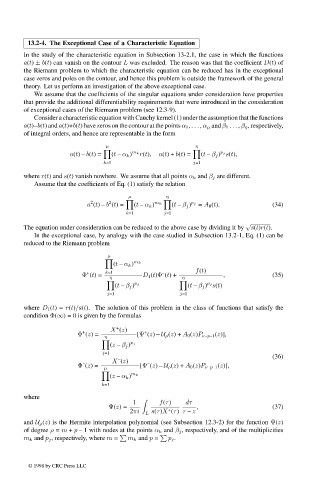Page 660 - Handbook Of Integral Equations
P. 660
13.2-4. The Exceptional Case of a Characteristic Equation
In the study of the characteristic equation in Subsection 13-2.1, the case in which the functions
a(t) ± b(t) can vanish on the contour L was excluded. The reason was that the coefficient D(t)of
the Riemann problem to which the characteristic equation can be reduced has in the exceptional
case zeros and poles on the contour, and hence this problem is outside the framework of the general
theory. Let us perform an investigation of the above exceptional case.
We assume that the coefficients of the singular equations under consideration have properties
that provide the additional differentiability requirements that were introduced in the consideration
of exceptional cases of the Riemann problem (see 12.3-9).
Consider a characteristic equation with Cauchy kernel (1) under the assumption that the functions
a(t)–b(t) and a(t)+b(t) have zeros on the contour at the points α 1 , ... , α µ and β 1 ... , β η , respectively,
of integral orders, and hence are representable in the form
µ η
p j
a(t) – b(t)= (t – α k ) m k r(t), a(t)+ b(t)= (t – β j ) s(t),
k=1 j=1
where r(t) and s(t) vanish nowhere. We assume that all points α k and β j are different.
Assume that the coefficients of Eq. (1) satisfy the relation
µ η
2
2
a (t) – b (t)= (t – α k ) m k (t – β j ) p j = A 0 (t). (34)
k=1 j=1
√
The equation under consideration can be reduced to the above case by dividing it by s(t)r(t).
In the exceptional case, by analogy with the case studied in Subsection 13.2-1, Eq. (1) can be
reduced to the Riemann problem
µ
(t – α k ) m k
f(t)
k=1
–
+
Φ (t)= D 1 (t)Φ (t)+ , (35)
η η
(t – β j ) p j (t – β j ) s(t)
p j
j=1 j=1
where D 1 (t)= r(t)/s(t). The solution of this problem in the class of functions that satisfy the
condition Φ(∞) = 0 is given by the formulas
+
X (z) +
+
Φ (z)= [Ψ (z) – U ρ (z)+ A 0 (z)P ν–p–1 (z)],
η
(z – β j ) p j
j=1 (36)
–
X (z) –
–
Φ (z)= [Ψ (z) – U ρ (z)+ A 0 (z)P ν–p–1 (z)],
µ
(z – α k ) m k
k=1
where
1 f(τ) dτ
Ψ(z)= , (37)
+
2πi L s(τ)X (τ) τ – z
and U ρ (z) is the Hermite interpolation polynomial (see Subsection 12.3-2) for the function Ψ(z)
of degree ρ = m + p – 1 with nodes at the points α k and β j , respectively, and of the multiplicities
m k and p j , respectively, where m = m k and p = p j .
© 1998 by CRC Press LLC
© 1998 by CRC Press LLC
Page 643

